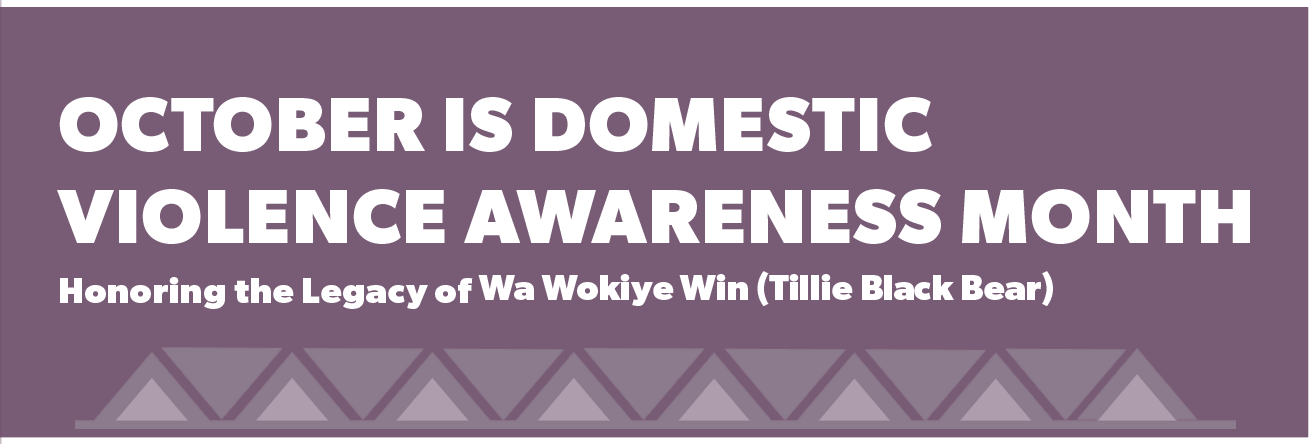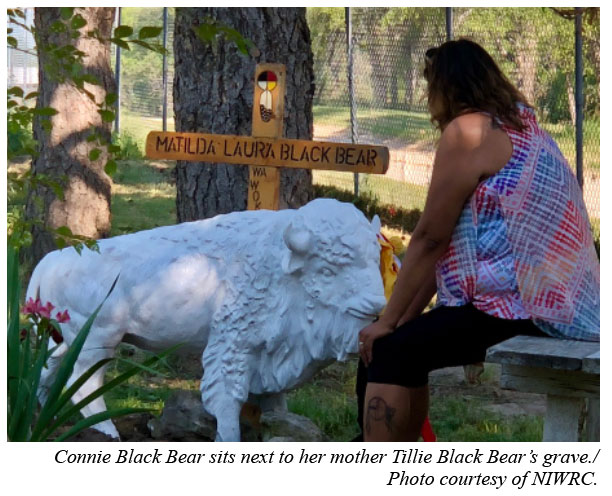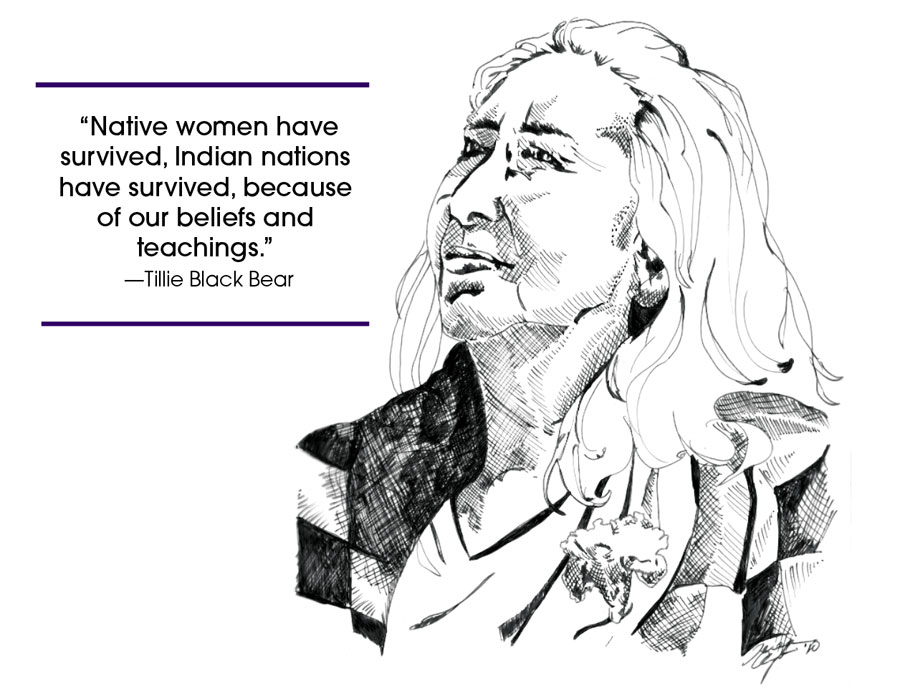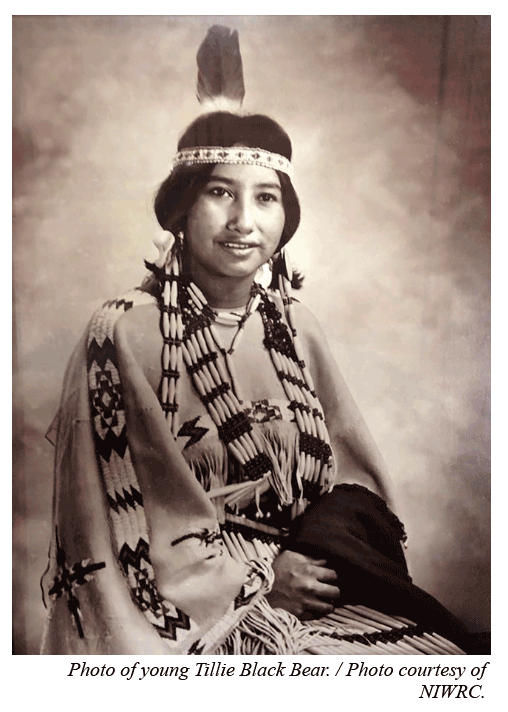
October is Domestic Violence Awareness Month | Honoring the Legacy of Wa Wokiye Win (Tillie Black Bear)
Originally conceived by the National Coalition Against Domestic Violence (NCADV), Domestic Violence Awareness Month (DVAM) evolved from a “Day of Unity” first held in October 1981. The intent was to connect the advocates across the nation who were working to end violence against women and children. The Day of Unity soon became an entire week devoted to a range of activities conducted at the local, Tribal, state, and national levels. The activities and themes varied from location to location, but included the common themes of mourning lives lost, celebrating survivors, and connecting those working to end the violence—themes that continue to shape current DVAM activities. The first DVAM was observed in October 1987, and in 1989, Congress designated October as National Domestic Violence Awareness Month. Matilda “Tillie” Black Bear was a founding mother of the NCADV and led in the national and Tribal organizing efforts to establish DVAM.
Tillie Black Bear Women Are Sacred Day, October 1st - Wa Wokiye Win, Woman Who Helps Everyone A large part of the legacy of U.S. colonization is the cultural genocide committed against Indigenous peoples. For the movement to increase safety for Native women, it is reflected in the erasing of the status and leadership roles of Native women, their names, struggles, and victories. The public honoring of historic personalities shapes who we, as a society, uphold as cultural icons.
A large part of the legacy of U.S. colonization is the cultural genocide committed against Indigenous peoples. For the movement to increase safety for Native women, it is reflected in the erasing of the status and leadership roles of Native women, their names, struggles, and victories. The public honoring of historic personalities shapes who we, as a society, uphold as cultural icons.
“As Indigenous peoples, and women, our story is not taught, recognized, or honored by mainstream America,” said Lucy Simpson, Executive Director for the National Indigenous Women’s Resource Center. This erasure from the public eye is part of the continuum of dehumanizing Native women. NIWRC as an anti-violence organization, we committed to unraveling the cultural foundations of violence against Native women. Telling our story is part of decolonizing.”
The federal laws and policies preventing full protection of Native women continue to legally justify the failed response of the government, but the social normalization of such violence is culturally based. The lack of public acknowledgment of the heroines that defended their nations, the grandmothers who stood against the criminalization of those ways of being a Native woman, must be challenged by inclusion and speaking our truth.
In 1978, Tillie Black Bear emerged as the first Native woman to advocate for battered Indian women at the national level, she continued in the movement for safety until her passage in 2014. Known to the movement as “Tillie,” she was well recognized as the Grandmother of the Battered Women’s Movement for her leadership spanning almost four decades. A citizen of the Rosebud Sioux Tribe, Tillie believed in the teachings of White Buffalo Calf Woman. One of the first teachings White Buffalo Calf Woman brought to the Lakota people was that, even in thought, women are to be respected. Tillie was given the Lakota name Wa Wokiye Win, which means “woman who helps everyone” in English, a name she fulfilled in life.
Tillie provided leadership at critical moments of our struggle for safety and sovereignty. Her handprints rest on historic national legislation and the founding of organizations to advance safety for women and a national agenda for strengthening the sovereignty of Indian nations.
In understanding the deep roots of violence against Native women, NIWRC encourages our movement, all progressive people, and this country to honor Tribal women leaders and celebrate their lives. By creating national holidays reflective of our reality as Indigenous women, we begin to challenge the cultural tolerance for violence against Native women.
Tillie’s Legacy of National Movement Organizing
As a young woman, Tillie testified at the first U.S. Commission on Civil Rights hearings on wife beating in 1978. That same year, Tillie went on to lead in building organizations that continue to serve as houses of the movement, such as the National Coalition Against Domestic Violence. At the same time, Tillie organized in her home communities on the Rosebud reservation, serving as a founding mother to the White Buffalo Calf Woman Society.
For the next three decades, Tillie’s leadership continued to indigenize federal legislation, including the Violence Against Women Act (VAWA), the Family Violence Protection and Services Act (FVPSA), Tribal Law and Order Act (TLOA), and much more. In 1995, after the passage of VAWA, Tillie met with the Department of Justice to plant a stake for VAWA to include Indian tribes. In 2000, Tillie helped shape the new VAWA Tribal coalition program. Tillie’s spirituality was constant, and in 2003, Tillie led a Wiping of the Tears ceremony at the Senate building to launch the struggle for the VAWA 2005 Safety for Indian Women Act. In 2011, as part of the National Congress of American Indians Task Force on Violence Against Women, Tillie met with United Nations Special Rapporteur Rashida Manjoo as a pathway to the VAWA 2013 victory, restoring jurisdiction over non-Indians to Indian tribes. This same year, Tillie again provided leadership to found the National Indigenous Women’s Resource Center.
Tillie’s understanding of social change, organizing, and movement building to make connections beyond the shelter doors to end violence against women are pillars of her legacy. Tillie understood the connection between safety and sovereignty for Native women, and she understood the strategic role of organization. Tillie received many awards during her lifetime, including the Eleanor Roosevelt Award for Human Rights from President Clinton in 2000.
“Tillie was well known for saying, ‘At any moment and any place we must be prepared to stand for Native women’” Simpson said. “Her understanding of social change, organizing, movement building, and making relatives are her living legacy. On October 1st, we will stand to honor Tillie as a heroine of our movement who inspired millions of people from all walks of life to end domestic and sexual violence.”
NIWRC will forever hold Tillie in our hearts and honor her dedication to the safety of Native women and the sovereignty of Indian nations. For this gift, we say thank you. And to her daughter, Connie, and Tillie’s entire family, we again thank you for sharing your beloved mother, sister, and Unci for almost four decades.
Introduction to ‘My Name Is Tillie Black Bear’
The following article is the first of two parts that Restoration will print from an interview with Tillie Black Bear on her life journey and the national movement she helped organize over the span of almost four decades, 1977–2014. Through her words, we can further understand why Tillie described the safety for Native women’s movement as a “movement of resistance,” and why the safety of Native women is linked to strengthening the sovereignty of Indian nations.
 My Name Is Tillie Black Bear
My Name Is Tillie Black Bear
I was born on December 10, 1946, at home in the small town of St. Francis on the Rosebud Sioux Indian reservation. The day after my birth, I was baptized into Catholicism as Matilda Laura Black Bear, but I grew up as Tillie. I am the third oldest of eleven children.
There is a belief among our people that we live in this world not as humans on a spiritual journey, but as spirits on a human journey. Lakota believe that the moment you are born, your spiritual being becomes a human being. And when you come into the world, the first person that touches you imparts their essence into you. This explained why I was the way I was.
When I was a young adult, I would visit my mother, and the aunties and grandmas would all be sitting there. I’d walk in probably a half hour late for lunch or something. As I’d meander in, my mom would say (in Lakota), “the woman who didn’t hurry” was the one who delivered me. The grandmas and aunties would look at me and go, “Hmm.” So throughout my lifetime, I think I always had the mannerisms of this elder.
A Catholic Education
As a child, I probably spoke maybe less than 10 words in English. When I was five, I started at a little public school in our community with probably not more than 30 other students. I lasted two weeks. At the end of the second week, the teacher sent me home with a note to my mother saying that I wasn’t school ready, that I needed to come back the next year. Of course I was disappointed because I thought I would be going to school, but then my uncles—my mother’s brothers—thought that was cool. They said (in Lakota), “She’s so smart. She finished her first year in two weeks.” (Typical Lakota humor.) They saw something real positive in that, and it made me feel better.
The next year, my mother enrolled me in the first grade at the St. Francis Catholic boarding school three blocks south of where we lived. The mission school was run by the Franciscan sisters out of Mary Christ in Denver, Colorado. The Jesuit I believe was Father Hause was from Milwaukee, Wisconsin. The first six weeks at school were very lonely. My long hair was cut short above my ears after I arrived; we all got haircuts. Every time someone from town came to the school, I would say, “Tell my mom I am here,” but my mother wouldn’t come up because she was afraid that I would walk home with her. She wanted to make sure I’d stay in school. So I ended up at the mission for 12 years.
I spoke very little Lakota during that time because you were shunned if you spoke Lakota. Those who communicated in the classroom were the ones who could speak English; the non-English speakers took a back seat. Sometimes our behavior was misinterpreted and we got punished for speaking our language. So I learned then that I had to pick up the English language very quickly.
We went to mass every day at 6:30 or 7:00 a.m. I really didn’t know anything about myself. I was just a tribal person growing up there. During the summer months, we got to go home, from the end of May to the end of August. At Christmas, we got to go home for two weeks.
In high school, I learned that my spirit was such that I was always being disciplined. The whole school was on a merit/demerit system, run military style with whistle blowing that commanded our behavior. During my tenth-grade year, I stayed at school all year because I didn’t earn the privilege of being able to go home on Sundays, from 10 to 5. The school had many rules and I learned that the rules were not always necessary to define who I was, and so I would go around the rules, and figure out how I could still manage to be who I was.
I graduated in my twelfth-grade year. By that time, I was a really strong Catholic product. I went on to a Catholic college about 300 hundred miles away, which was also run by Catholic nuns. After three semesters, I dropped out and went home.
Coming Home to Lakota Beliefs
I came home and went to business school to pick up accounting. Afterwards, I worked for the tribe’s Equal Opportunity Employment program for about a year, until I decided that I would go back to college. I went to college off the reservation because we didn’t have a community college on the reservation at that time. I spent two full semesters and three summers getting my bachelor’s in secondary education. I moved home, and eventually went back to the university to work on my master’s in counseling.
 During that time, I lived in a very traditional way. My family all spoke Lakota and believed in our practices, as well as embraced Catholicism. When my aunt went through heart surgery, I remember I kept hearing and hearing this sun dance song. Finally I got up and prayed for my aunt’s wellness, and said I would sun dance for her health. At the same time my uncle, who saw a medicine person, made the same pledge, the same vow. My aunt came through alright.
During that time, I lived in a very traditional way. My family all spoke Lakota and believed in our practices, as well as embraced Catholicism. When my aunt went through heart surgery, I remember I kept hearing and hearing this sun dance song. Finally I got up and prayed for my aunt’s wellness, and said I would sun dance for her health. At the same time my uncle, who saw a medicine person, made the same pledge, the same vow. My aunt came through alright.
The following summer, at age 26, I sun danced to fulfill my pledge. It was my first time and I danced with my uncle at Crow Dog’s sun dance. They called it Crow Dog’s paradise. My mother was a very strong tribal woman. She dressed me in a buckskin dress. My uncle, who was a medicine person, made the reed for my hair and my arms. He cut two eagle feathers for me to wear in my hair like the men did. They took me there early in the morning so I could go into the sweat lodge with the sun dancers. At the end of that day, because I was fulfilling a vow for my aunt, they fed the people and had a giveaway. That was my first, real introduction to our tribal ways.
I grew up in a time when the healing ceremonies had to be held in secret. When I was in the eighth grade, I can remember being home when they were having a ceremony at night. Sentries were posted a block or two away looking out for the Catholic priests or the police. I grew up in that era. My family was one of those that went underground with the traditional ways—traditional spiritual practices. I started to practice those old ways, and today I call myself a recovering Catholic. Just like a recovering alcoholic, I still find myself in church sometimes for weddings, baptisms, or confirmations.
The Call: Joining the Battered Women’s Movement
After I got my master’s, I went home with my two daughters. I had gotten into a relationship with a man who was very abusive. I was already working at Cangleska University as Dean of Student Services; I had my own home, and I was always very independent. Yet I got involved with a man who was abusive.
It took me probably about two years to leave that relationship. I was fortunate that he was from another reservation. If it wasn’t for the strength that came from my family and my children, I probably would have stayed in that relationship a lot longer. My cousins kept talking to me and my aunts kept talking to me, and I eventually left the relationship. After that, I was really involved in my family again and everything was centered around my family.
I decided to leave the reservation for a while and went to university for my doctoral studies. While working on my doctorate in counseling (counselor education), I got a call from my friend Faith Spotted Eagle who was president/chair of the White Buffalo Calf Woman Society. Dialogue had started about White Buffalo Calf around 1976, and the organization was formed in December 1977. Faith asked if I would go to Washington, D.C., to represent White Buffalo Calf Woman Society. The U.S. Civil Rights Commission was having a two-day symposium on what they called “wife battering,” and she asked if I would talk about the short-term needs of victims. I agreed to go because I just came out of an abusive relationship. I had survived.






